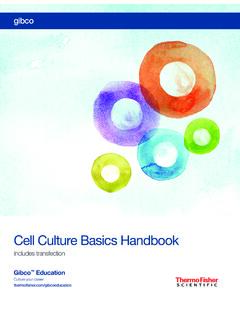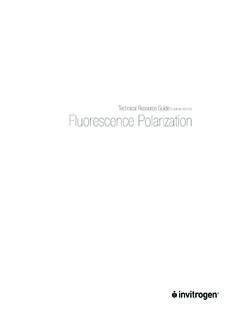Transcription of CHAPTER 1 Introduction Fluorophores and Introduction to ...
1 IntroductionIntroduction to fluorescence TechniquesMolecular Probes HandbookA Guide to Fluorescent Probes and Labeling Technologies11th Edition (2010) CHAPTER 1 Fluorophores and Their Amine-Reactive DerivativesThe Molecular Probes HandbookA GUIDE TO FLUORESCENT PROBES AND LABELING TECHNOLOGIES11th Edition (2010)Molecular Probes ResourcesMolecular Probes Handbook (online version)Comprehensive guide to uorescent probes and labeling SpectraViewerIdentify compatible sets of uorescent dyes and cell structure Journal of Cell Biology ApplicationsAward-winning magazine highlighting cell biology products and all Molecular Probes educational resources at Probes ResourcesMolecular Probes Handbook (online version)Comprehensive guide to fl uorescent probes and labeling technologiesthermofi Probes fluorescence SpectraViewerIdentify compatible sets of fl uorescent dyes and cell structure probesthermofi Journal of Cell Biology ApplicationsAward-winning magazine highlighting cell biology products and applicationsthermofi all Molecular Probes educational resources at thermofi to fluorescence Techniques3 IMPORTANT NOTICE: The products described in this manual are covered by one or more Li mited Use Label Li cense(s).
2 Please refer to the Appendix on page 971 and Master Product Li st on page 975. Products are For Research Use Only. Not intended for any animal or human therapeutic or diagnostic Molecular Probes Handbook: A Guide to Fluorescent Probes and Labeling TechnologiesFigure 1 Jablonski diagram illustrating the processes involved in the creation of an excited electronic singlet state by optical absorption and subsequent emission of uorescence. The labeled stages 1, 2 and 3 are explained in the adjoining S1h EM23h EX1 Fluorescent probes enable researchers to detect particular com-ponents of complex biomolecular assemblies, such as live cells, with exquisite sensitivity and selectivity. e purpose of this Introduction is to brie y outline uorescence principles and techniques for newcomers to the fluorescence ProcessFluorescence is the result of a three-stage process that occurs in certain molecules (generally polyaromatic hydrocarbons or hetero-cycles) called uorophores or uorescent dyes.
3 A uorescent probe is a uorophore designed to respond to a speci c stimulus or to localize within a speci c region of a biological specimen. e process respon-sible for the uorescence of uorescent probes and other uorophores is illustrated by the simple electronic-state diagram (Jablonski diagram) shown in Figure 1: ExcitationA photon of energy h EX is supplied by an external source such as an incandescent lamp or a laser and absorbed by the uorophore, creat-ing an excited electronic singlet state (S1 ). is process distinguishes uorescence from chemiluminescence, in which the excited state is populated by a chemical 2: Excited-State Lifetime e excited state exists for a nite time (typically 1 10 nano-seconds). During this time, the uorophore undergoes conformational changes and is also subject to a multitude of possible interactions with its molecular environment.
4 Ese processes have two important con-sequences. First, the energy of S1 is partially dissipated, yielding a re-laxed singlet excited state (S1) from which uorescence emission origi-nates. Second, not all the molecules initially excited by absorption (Stage 1) return to the ground state (S0) by uorescence emission. Other process-es such as collisional quenching, uorescence resonance energy trans-fer (FRET) ( fluorescence Resonance Energy Transfer (FRET) Note ) and intersystem crossing may also depopulate S1. e uorescence Introduction to fluorescence Techniquesquantum yield, which is the ratio of the number of uorescence photons emitted (Stage 3) to the number of photons absorbed (Stage 1), is a mea-sure of the relative extent to which these processes 3: fluorescence EmissionA photon of energy h EM is emitted, returning the uorophore to its ground state S0.
5 Due to energy dissipation during the excited-state life-time, the energy of this photon is lower, and therefore of longer wave-length, than the excitation photon h EX. e di erence in energy or wavelength represented by (h EX h EM) is called the Stokes shi . e Stokes shi is fundamental to the sensitivity of uorescence techniques because it allows emission photons to be detected against a low back-ground, isolated from excitation photons. In contrast, absorption spec-trophotometry requires measurement of transmitted light relative to high incident light levels at the same Spectra e entire uorescence process is cyclical. Unless the uorophore is irreversibly destroyed in the excited state (an important phenomenon known as photobleaching), the same uorophore can be repeatedly ex-cited and detected. e fact that a single uorophore can generate many thousands of detectable photons is fundamental to the high sensitiv-ity of uorescence detection techniques.
6 For polyatomic molecules in solution, the discrete electronic transitions represented by h EX and h EM in Figure 1 are replaced by rather broad energy spectra called the uorescence excitation spectrum and uorescence emission spectrum, respectively (Table 1). e bandwidths of these spectra are parameters of particular importance for applications in which two or more di er-ent uorophores are simultaneously detected . e uorescence excita-tion spectrum of a single uorophore species in dilute solution is usu-ally identical to its absorption spectrum. e absorption spectrum can therefore be used as a surrogate excitation spectrum data set. Under the same conditions, the uorescence emission spectrum is independent of the excitation wavelength, due to the partial dissipation of excitation energy during the excited-state lifetime, as illustrated in Figure 1. e emission intensity is proportional to the amplitude of the uorescence excitation spectrum at the excitation wavelength (Figure 2).
7 Figure 2 Excitation of a uorophore at three di erent wavelengths (EX 1, EX 2, EX 3) does not change the emission pro le but does produce variations in uorescence emission inten-sity (EM 1, EM 2, EM 3) that correspond to the amplitude of the excitation 3EX 1EX 2EM 3EM 1EM 2 WavelengthFluorescence excitationFluorescence emissionThe Molecular Probes Handbook: A Guide to Fluorescent Probes and Labeling TechnologiesIMPORTANT NOTICE : The products described in this manual are covered by one or more Limited Use Label License(s). Please refer to the Appendix on page 971 and Master Product List on page 975. Products are For Research Use Only. Not intended for any animal or human therapeutic or diagnostic to fluorescence NOTICE: The products described in this manual are covered by one or more Li mited Use Label Li cense(s). Please refer to the Appendix on page 971 and Master Product Li st on page 975.
8 Products are For Research Use Only. Not intended for any animal or human therapeutic or diagnostic Molecular Probes Handbook: A Guide to Fluorescent Probes and Labeling TechnologiesFluorescence DetectionFluorescence InstrumentationFour essential elements of uorescence detection systems can be identi ed from the preceding discussion: 1) an excitation source, 2) a uorophore, 3) wavelength lters to isolate emission photons from excitation photons, 4) a detector that registers emission photons and produces a recordable output, usually as an electrical signal. Regardless of the application, compatibility of these four elements is essential for optimizing uorescence instruments are primarily of four types, each provid-ing distinctly di erent information: Spectro uorometers and microplate readers measure the average properties of bulk ( L to mL) samples.
9 fluorescence microscopes resolve uorescence as a function of spa-tial coordinates in two or three dimensions for microscopic objects (less than ~ mm d ia meter). fluorescence scanners, including microarray readers, resolve uo-rescence as a function of spatial coordinates in two dimensions for macroscopic objects such as electrophoresis gels, blots and chromatograms. Flow cytometers measure uorescence per cell in a owing stream, allowing subpopulations within a large sample to be identi ed and types of instrumentation that use uorescence detection include capillary electrophoresis apparatus, DNA sequencers 1 and micro uidic ,3 Each type of instrument produces di erent Table 1 Spectroscopic proterties of uorescent nitionSigni canceFluorescence excitation spectrum *An X,Y plot of excitation wavelength versus number of uorescence photons generated by a instrument setup should deliver excitation light as close to the peak of the excitation spectrum of the uorophore as spectrumAn X,Y plot of wavelength versus absorbance of a chromophore or a rst approximation, the absorption spectrum of a uorophore is equivalent to the uorescence excitation spectrum.
10 To the extent that this approximation holds, the absorption spectrum can be used as a surrogate for the uorescence excitation emission spectrum *An X,Y plot of emission wavelength versus number of uorescence photons generated by a emission spectral discrimination is the most straightforward basis for multiplex detection and for resolving probe uorescence from background auto coe cient (EC)Capacity for light absorption at a speci c wavelength. fluorescence output per uorophore ( brightness ) is proportional to the product of the extinction coe cient (at the relevant excitation wavelength) and the uorescence quantum quantum yield (QY)Number of uorescence photons emitted per excitation photon Extinction coe cient. QuenchingLoss of uorescence signal due to short-range interactions between the uorophore and the local molecular environment, including other uorophores (self-quenching).















